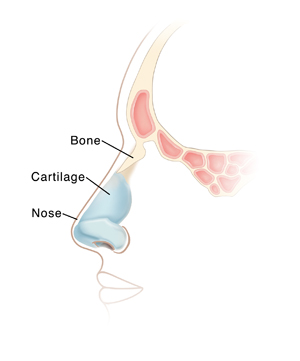Nose Fracture, No X-Ray

Based on your exam today, you have a broken bone, or fracture, of the nose. Some fractures are obvious and an X-ray is not needed to make the diagnosis. A nose fracture will cause pain, swelling, and nasal stuffiness. Sometimes, there is also bleeding from the nose. It's common to get bruising around your eyes by the next day.
If you have a major break, parts of your nose bone are pushed out of place. A major break that changes the shape of your nose must be treated by a nose specialist, called an ENT (ear, nose, and throat) doctor. The ENT doctor will straighten the bones in your nose. This is called a reduction. Some fractures may need a reduction as soon as possible, such as when bleeding from the nose won’t stop. Otherwise, it's best to wait a few days until the swelling has gone down. Then the doctor can better see when your nose is back in the right position. You may have an X-ray before and after the procedure.
Home care
-
You will likely be prescribed medicine for pain. Take this medicine as directed.
-
Apply an ice pack every 1 to 2 hours for the first day. Continue with ice packs 3 to 4 times a day for the next 2days, then as needed to ease pain and swelling. To make an ice pack, put ice cubes in a plastic bag that seals at the top. Wrap the bag in a clean, thin towel or cloth. Never put ice or an ice pack directly on the skin.
-
Tell your healthcare provider if you are taking aspirin or blood-thinning medicines. These medicines make it more likely that your nose will bleed. Your provider may need to change your dose.
-
Don’t drink alcohol or hot liquids for the next 2 days. Alcohol or hot liquids in your mouth can dilate blood vessels in your nose and cause bleeding.
-
Don’t blow your nose for the first 2 days. Then, do so gently so you don’t cause bleeding.
-
Don’t play contact sports until approved by your provider, unless you can protect your nose from getting injured again. You can wear a special custom-fitted plastic face mask to protect your nose.
Special note on concussions
If you had any symptoms of a concussion today, don’t return to sports or any activity that could result in another head injury.
These are symptoms of a concussion:
-
Nausea
-
Vomiting
-
Dizziness
-
Confusion
-
Headache
-
Memory loss
-
Loss of consciousness
Wait until all of your symptoms are gone and your provider says it’s OK to resume your activity. Having a second head injury before you fully recover from the first one can lead to serious brain injury.
Follow-up care
Follow up with your healthcare provider, or as advised. If your nose looks crooked or if you continue to have trouble breathing through one or both sides of your nose after the swelling goes down, call the ENT doctor. If you have trouble getting an ENT appointment, call your regular healthcare provider or return here.
When to seek medical advice
Call your healthcare provider right away if any of the following occur:
-
Bleeding from the nose that is not controlled by pinching the nostrils together for 15 minutes
-
Increasing facial swelling, pain, or redness
-
Fever of 100.4ºF (38ºC) or higher, or as directed by your healthcare provider
-
Chills
-
Unable to breathe from both sides of the nose after swelling goes down
-
Sinus pain
Call 911
Call 911 if you have:
-
Repeated vomiting
-
Headache or dizziness that is severe or gets worse
-
Abnormal drowsiness, or unable to awaken
-
Confusion or change in behavior or speech
-
Convulsion or seizure